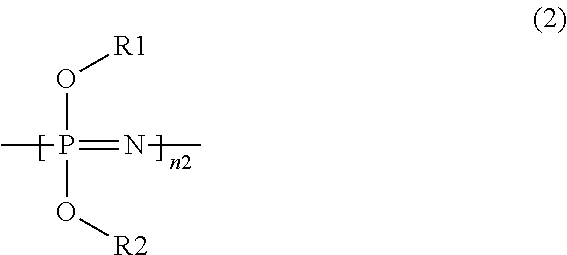Flame retardant resin composition and molded article thereof
a technology of flame retardant resin and composition, which is applied in the direction of organic chemistry, group 5/15 element organic compounds, chemistry apparatus and processes, etc., can solve the problems of difficult to impart high flame retardancy, no example where practicable impact resistance and flame retardancy are achieved, and the impact resistance of paf has not been improved. , to achieve the effect of high impact resistance and flame retardancy, low environmental load
- Summary
- Abstract
- Description
- Claims
- Application Information
AI Technical Summary
Benefits of technology
Problems solved by technology
Method used
Image
Examples
examples
[0031]The present invention will hereinafter be described in detail by the following Examples. However, the present invention is not limited by these examples.
Synthesis of polyethylene-2,5-furan dicarboxylate
[0032]A 10-L SUS-made separable flask equipped with a nitrogen inlet tube, a fractionating-cooling column and an SUS-made agitating blade were provided. This separable flask was charged with 2,300 g (14.7 mol) of 2,5-furan dicarboxylic acid and 2,758 g (44.2 mol) of ethylene glycol, and then charged with 4.2 g (12.3 mmol) of titanium butoxide and 4.1 g (19.6 mmol) of monobutyltin oxide as catalysts.
[0033]Agitation was started while introducing nitrogen, and at the same time, a power source of a mantle heater was turned on to heat the contents to 150° C. At the time the internal temperature reached 150° C., outflowing of the by-product water attending on a condensation reaction started. When the reaction was continued for 1 hour at internal temperatures of 160° C. and 165° C. eac...
examples 1 to 3
, and Comparative Examples 1 to 5
[0034]PEF obtained by the above-described process was vacuum-dried for 6 hours at 120° C. Pellets of an aromatic polycarbonate resin were hot-air-dried for 6 hours at 120° C. The above-described PEF and aromatic polycarbonate resin, and compounding additives shown in Table 1 or 2 were weighed so as to give a mass ratio shown in Table 1 or 2 and mixed. Thereafter, the resultant mixture was melted and kneaded at a cylinder temperature of 215° C. to 230° C. by a twin-screw extruder (Laboplast Mill, trade name, manufactured by Toyo Seiki Seisakusho Co., Ltd.). The resin extruded from the tip of the extruder was cut into pellets. The resultant pellets were vacuum-dried for 6 hours at 90° C. and then molded into a multipurpose test specimen (80 mm×10 mm×t (thickness)=4 mm) and a specimen (125 mm×12.5 mm×t 2 mm) for flame retardant tests at a cylinder temperature of 210° C. to 235° C. and a mold temperature of 50° C. by means of an injection molding machine...
examples 4 and 5
[0035]A multipurpose test specimen and a specimen for flame retardant tests were molded from the resin in the same manner as in Examples 1 to 3 except that the cylinder temperature upon melting and kneading was changed to 240° C. to 245° C., and the cylinder temperature upon molding was changed to 260° C. to 310° C.
PUM
| Property | Measurement | Unit |
|---|---|---|
| temperature | aaaaa | aaaaa |
| temperatures | aaaaa | aaaaa |
| temperatures | aaaaa | aaaaa |
Abstract
Description
Claims
Application Information
 Login to View More
Login to View More - R&D
- Intellectual Property
- Life Sciences
- Materials
- Tech Scout
- Unparalleled Data Quality
- Higher Quality Content
- 60% Fewer Hallucinations
Browse by: Latest US Patents, China's latest patents, Technical Efficacy Thesaurus, Application Domain, Technology Topic, Popular Technical Reports.
© 2025 PatSnap. All rights reserved.Legal|Privacy policy|Modern Slavery Act Transparency Statement|Sitemap|About US| Contact US: help@patsnap.com



